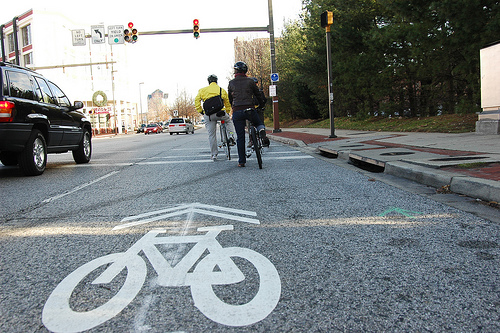 A sharrow in Baltimore. Photo: Elly BlueVisiting Seattle last weekend, it was impossible not to notice that its streets are absolutely covered in sharrows. “It’s almost like they polluted the streets with them,” said Tom Fucoloro, proprietor of the Seattle Bike Blog, who took me on a walk through the city’s Central District, pointing out its transportation features.
A sharrow in Baltimore. Photo: Elly BlueVisiting Seattle last weekend, it was impossible not to notice that its streets are absolutely covered in sharrows. “It’s almost like they polluted the streets with them,” said Tom Fucoloro, proprietor of the Seattle Bike Blog, who took me on a walk through the city’s Central District, pointing out its transportation features.
A “sharrow” — the word is an amalgamation of “arrow” and “share the road” — is a larger-than-life thermoplastic symbol of a bicycle topped by two chevrons pointing the way forward. More technically known as “shared lane markings,” they’re intended to remind two-wheeled and four-wheeled road users alike to share with each other, and also to encourage people on bikes to take the lane when it’s too narrow to ride side-by-side with car traffic.
Sharrows have been increasing in popularity nationwide, and got a boost in 2009 when they were officially entered into the federal transportation engineering canon. Seattle got a head start, writing them into its 2007 Bike Master Plan. Other cities began earlier, but I’ve never seen such a profusion as in the Emerald City.
Like many experts on transportation bicycling, Fucoloro wasn’t enthusiastic about them. Sharrows are spread so indiscriminately on Seattle streets, he said, that “they mean nothing now.” He has noticed that there seems to be “slightly less aggression” from drivers when they’re in place. “But does that mean all the streets without sharrows are worse?”
In other words, with sharrows everywhere, do drivers assume that cyclists don’t belong on streets without them?
Fucoloro is not the only one to express that concern, but he and others seem to be watching and waiting as cities feel out how best to use them. Some early adopters, including Sacramento and Baltimore, initially put sharrows on busy roads all the way to the right, where riders would be squeezed between fast car traffic and parked cars — right in the dreaded “door zone.” Federal regs now say that sharrows must be at least four feet from the curb if there’s no parking, 11 feet from the curb if there is.
Seattle has its own brand of sharrow growing pains. Riding and walking around town, it’s hard to see a logic to the streets chosen for sharrow treatment. Some are on relatively quiet back streets, others are on breathtakingly fast arterials where the symbols are worn and rutted by the daily flow of cars and trucks speeding over them.
Sharrows are popular because they are politically easy — you can almost hear city officials sigh with relief when sharrows are mentioned. On the surface, they seem like a way to please the increasingly vocal bike lobby without ruffling feathers by putting in a bike lane at the expense of car parking or traffic lanes, which are often perceived as being for cars only. And they’re cheap: Sharrows cost only $229 each to install, including labor and materials, while a full-blown bike lane can cost between $5,000 and $60,000 per mile.
But do sharrows work? One recent study says sharrows slow car traffic slightly, and make bicyclists a little safer. But they are even better at keeping drivers at a distance from parked cars — once again, bike infrastructure benefits more than just people on bikes.
Fucoloro’s conclusion about sharrows: “They’re better as wayfinding signs” rather than safety tools.
Portland’s take on the sharrow meme bears this theory out. Last summer, my hometown experienced a sudden sharrow explosion, as an influx of federal stimulus money was used in part to paste them en masse on an extensive network of low-traffic, neighborhood streets in our northeast quadrant. Laid out smack in the middle of the road, they’re meant to show all road users where people on bikes can ride most safely — but in practice their main usefulness has been to map out bikeable routes across town.
And this, Fucoloro said, points the way to sharrow’s ultimate future, at least in Seattle. They are helping pave the way, politically and on the ground, for the next big thing: neighborhood greenways — designated networks of residential streets that ease walking and biking by discouraging fast car traffic and calming areas where pedestrians cross streets.
“We have a lot of busy streets separating schools and parks, and there’s a need for families and kids to have a safe way to get around,” Fucoloro explained. Greenways fulfill this need. Neighborhood groups have been demanding them, he said, and “lots of them aren’t bikers at all.”
A recent ballot measure in Seattle would have raised car registration fees by $60 per year to fund active transportation projects, including thousands of dollars a year in neighborhood greenways, Fucoloro said. But the initiative was defeated.
“I think the city was going to take bike infrastructure to the next level, and Prop 1 was going to give us a push,” Fucoloro said. “Now I don’t know what we’re going to do — we’ll just keep half-assing it, I guess.”
Half-assed or not, sharrows are a feasible right-now hack for Seattle’s — or any other city’s — streets in a time when the mere mention of bicycle transportation in a public forum can produce an upswell of anti-bike grumbling and threats of vehicular violence. Done wrong or inconsistently, they can make streets slightly more dangerous for bicycling. Done right, they can point the way to the future.



